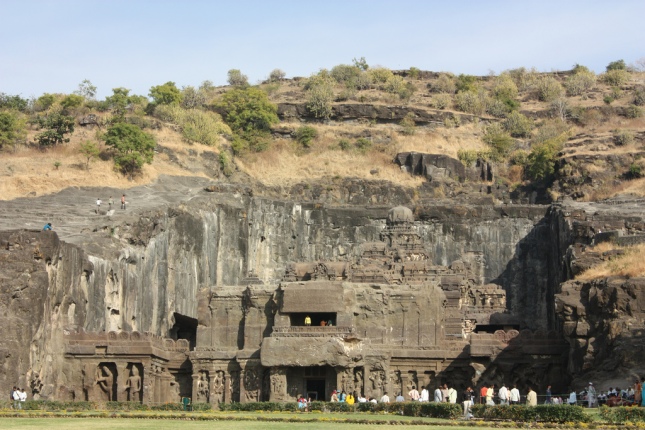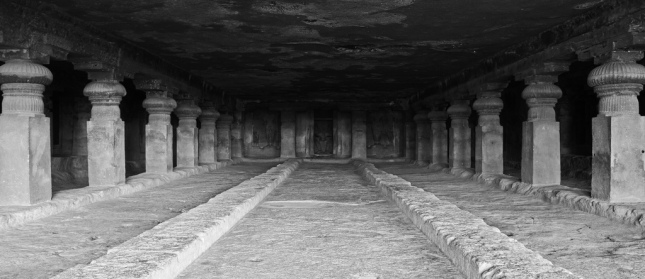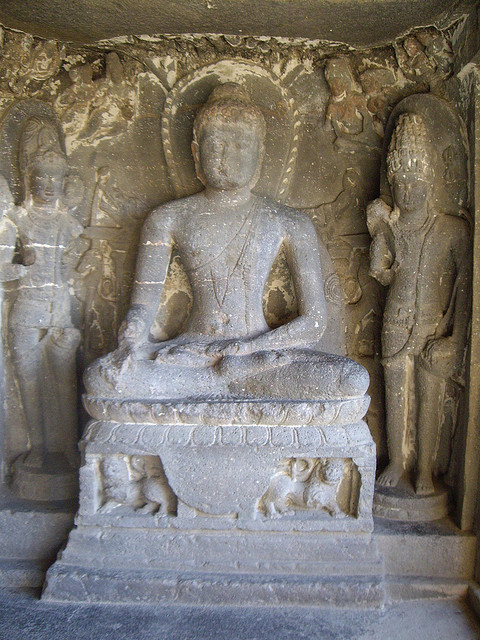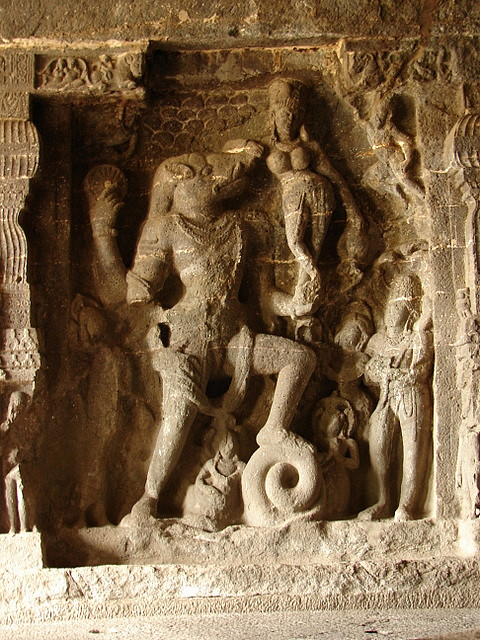
Ellora Caves, one of the heritage sites credited by UNESCO is an impressive site of Buddhist, Hindu and Jain cave temples built between 6th and 10th centuries A.D. near the Indian village of Ellora. These caves locally called as ‘Verul Leni’. This site contains many exquisite sculptures. It is the most visited monument in Maharashtra state. Tourists flock in a large number there. One can enjoy visiting these caves maximally during the monsoon season as the nearby stream is filled with water and the local environs become lush green.
About History
Ellora caves were carved out when the Ajanta caves were abandoned. These caves were excavated from a large volcanic rock, the Charanandri hills. This hill plateau is in the semi-circular shape. When Buddhism was declining and Hinduism was growing, then these caves were excavated.

The last building activity took place when the local rulers switched consecration from Shaivism to the Digambara sect of Jainism. Three different structures of different religions exist together there, that shows secularism in India, due to this it was designated as a UNESCO World Heritage Site in 1983.
In total, there are nearly 100 caves in a hilly region out of which 34 caves are famous and the most visited. Numerous written records indicate that these caves were visited regularly by rhapsodized travelers. These caves have not only witnessed the three great religions but also illustrate the characteristics of ancient India and the spirit of tolerance.
These breathtaking caves are worth visiting for their remarkable sculptures, paintings, and architectures. Buddhist group was the oldest in excavation and it comprises monasteries and a large temple of Buddha, then the caves of Brahmin group were excavated which are the best caves of the Ellora, and in the last Jain group was excavated. These caves are decorated beautifully and the visitors entice by its beauty greatly.
About the Caves
Total 34 caves are there which are mostly visited by tourists. In all these caves, some of them belonging to Buddhism (12 Caves), Hinduism (17 Caves) and Jainism (5 Caves). These are numbered chronologically, starting from the Oldest Buddhist Caves.
Buddhist caves are the earliest or oldest caves dating back from 500 to 750 AD. All these caves contain the sculptures of Buddha in various postures. These caves are decorated elaborately . Hinduism caves are dated back from 600 AD and after that only the Jainism caves were excavated. Cave nos. 2, 5, 10 & 12 are belong to Buddhist group and Cave nos. 14, 15, 16, 21 &29 belongs to the Brahmanical group and Caves 32 & 34 belong to the Jain group, these are the most visited and famous caves. By visiting these caves, you will have a glimpse of all the three religions together, i.e. Buddhism, Hinduism and Jainism.
Here is the brief description of the main caves visited most by the tourists.
Cave 1 – 2 – 3 – 4 – 5

Cave 1 is a plain monastery contains eight cells and a large hall. It has very few sculptures and even not painted & designed elaborately.

Cave 2 is a Buddhist cave, so lots of people visit it surely. It has a central chamber with 12 great pillars and is lined with sculptures of seated Buddha on a lion throne. The doorway of the monastery is surrounded by a muscular Padmapani, holding a lotus and a bejeweled Maitreya, the future Buddha, indicates that it is the cave of Buddha.
Cave 3 and 4 are so much similar in design as that of Cave 2 but not much developed and in poor condition.

Cave 5, also known as the Maharwada Cave as it was used by the tribal men at that time as a shelter in monsoon. It is one of the Buddha caves. It contains a grand hall, two rows of carved benches, and a portrait of Buddha. Another shrine of Buddha is in the hall, in a sitting posture on a stool while touching his right hand on the ground, as in the Earth Witness gesture.
Cave 6 – 7 – 8 – 9 – 10 – 11 – 12

Cave 6 is the home of two finest structures at Ellora. On the parched doorway, there is goddess Tara on the left side with a fierce but kind expression. On the right side, there is Mahamayuri, the Buddhist goddess of learning, seated on the peacock. An industrious student sits at his desk below. So we can say that Mahamayuri has a very similar characteristics to her counterpart, Saraswati.
Cave 7 is a monastery that is undeveloped, pillars are broken away. On the back wall, five cells are connected and of which two cells are finished. It is visited by less tourists.

Cave 8 consists of two halls and a shrine of Buddha. The inner hall with three cells on the north side and is cut off by pillars at each end. The shrine of Buddha has attendants at the door and inside of it there is a seated Buddha with his attendants. On the south wall, there is a sculpture of the Mahamayuri similar to that of Cave 6. On the back wall, there is a seated Buddha with Bodhisattva Padmapani and Vajrapani on each side of the wall.

Cave 9 has a well carved facade and consists of outer balcony and an inner portico having two pillars, square from below and octagonal from above. Three Chaitya windows are there, ornamented well and each of them occupied by a figure of Buddha and many small figures are carved on the side of the seated Buddha. On the left side of the Buddha, there is a Padmapani with female attendants.

Cave 10, a famous cave of the Buddha group also Known as “Vishwakarma Cave” dates back to 700 A.D. and is known as the Carpenter’s cave because of its imitation in stone of wooden beams on the ceiling. It contains a chaitya hall. At the far end of the cave, a seated Buddha is enthroned in front of a large stone Stupa.
Cave 11 is locally known by the people as the Doha Tal or “Two Floors” cave. The top floor of this cave is just a long hall having columns on both the sides. There are many sculptures of the Buddha and other goddesses. Shrine of Buddha is located there and also the images of Ganesh and Durga are placed there. Both images show that after the caves were abandoned by the Buddha, this cave was converted into a Hindu temple.

Cave 12, locally known as Tin Tal as it has three floors in it. It has an impressive upper hall which is big enough. The walls of the shrine are lined with five Bodhisattvas and flanked by seven Buddhas. This cave is decorated beautifully.
Cave 13 – 14 – 15 -16
Cave 13 located to the left of the Tin Taal. It has a plain room in it. Front of the cave had been destroyed by the decay of the rock. Now it is a kind of a rest house for visitors.
Cave 14 is a Brahmanical cave, with four pillars in front and twelve inside the open hall, all of them carved. Its long wall is adorned with magnificent carved friezes and the entrance to the sanctuary is guarded by the river goddesses Ganga and Yamuna. Female scriptures of Ganesh and cadaverous goddesses of death, Kala and Kali. Many visitors come to visit this.
Cave 15 was a Buddhist cave, later it is adopted by the Hindus. The ground floor is not much interesting, but the top floor has lots of the best sculptures of Ellora. On the right wall, there is a sequence of panels having ten incarnations of Lord Vishnu and due to only this, the name of the cave is Das Avatara. Sculptures of Shiva as Nataraja, the cosmic dancer is amazingly depicted.
Cave 16 is a very notable Hindu cave but not a cave at all. It is a magnificent temple carved from a solid rock, patterned closely on the freestanding temples of the time. It contains many sculptures of Mount Kailash, known as the Kailash temple. It has a thick coat of white plaster that looks a snowy mountain on which this temple is located. This temple has stupendous architecture, with interesting spatial effects and varied sculptures. It took 100 years to complete and covers an area double the size of the Parthenon in Athens. Now-a-days it becomes a hub for tourists.
Cave 17 – 18 – 19 – 20 – 21
Cave 17 belongs to the Hindu caves, and carved between 600 and 870 AD. This cave has a main emphasis on female. Many female sculptures with their attendants are there. It occupies the center of the cave complex and attached to the Kailash Temple from all sides. Elaborately decorated this cave is visited by lots of tourists and pilgrims.
Cave 18 is a plain cave, having a vestibule or antechamber with two pillars and corresponding pilasters in front. On the pillars, the few letters of a painted inscription in Devanagari script are still visible. It has many features to allure visitors in every manner. Late circular form of the pitha in the shrine, and the octagonal section has been added to the midsection of the lingam.
Cave 19 is a massive square piece holds the large linguine and is composed of a square base with a rounded top. Some part of the roof’s cave has been reconstructed and excavated completely. The front pillars have gone now. The dwarpalas of the cave are of good height with minimum embellishment. Many visitors come over here to to see the ornamental quality of the cave.
Cave 20 is divided into two sub-caves i.e. Cave 20 A and 20 B. Earlier, it has two pillars but now they are gone. It is just a facade having columns with Kubera on the left side of the cave. Outside the facade, on the north there is a Ganpati, and on the south there is sculpture of Mahishasuri. It has a wide circumambulatory round to see the cave more prominently. On each side of a door is a tall dwarapala with a small female figure. Victory pillar and the remains of a pedestal for a Nandi is located on the platform outside the cave.
Cave 21 the oldest Hindu cave at Ellora which dates back from the late 500s. Famous as only Rameshwara among the local people not by their cave number. It houses many fine sculptures, including a pair of river goddesses, two door guardians and a number of loving couples around the walls of the balcony that makes this cave very graceful. Lots of tourists visit this cave.
Cave 22 – 23 – 24 – 25 – 26 – 27 – 28

Cave 22 contains a few sculptures of Ganesha, the three devils, one on crocodile and a four armed Vishnu. In the shrine, there is a pedestal and a highly polished linga. Blue streaks appear on the linga, so it is named Nilakanta. On the south side of the cave, there is chapel with Astamatrikas, or the eight mothers, all four armed and the eighth with three arms. Many sculptures are worth visiting.
Cave 23 is a cave consists of a partly double verandah with five doors entering into small cells. A small sculpture of Trimurti located on the back side of the wall. It is less visited by the visitors.

Cave 24 contains five low cells called Teli-Ka-Gana. It has many small sculptures. Due to the fall off a cliff, entrance of the cave had been made and has stopped further progress as the rock was unsuitable for carving.

Cave 25 is also known as Kunbharwada. Earlier, its front part has been supported by large columns and pilasters but now it has fallen away. An image has been placed on a pedestal and a recess with a shrine behind it containing an oblong altar. Many sculptures of the Sun and god Surya with his chariot attract lots of crowds.

Cave 26 is much similar to that of the Elephanta cave. It contains four pillars in front, two pilasters and also on the back side, there are two pilasters. In front of each pillar, there is a dwarf attendant. The door of the shrine is occupied by two large dwarpalas, one with a flower, and another standing stout. Also the shrine contains a Linga.

Cave 27 is located on the edge of a ravine which separates it from the last Saiva cave and over the scarp, a fine waterfall is there that is also called Sita-Ki-Nahani. Visited mostly by tourist only due to its exquisite waterfall.













bnomadic
July 31, 2013 at 12:16 pm
Informative piece.
seniorhiker
August 1, 2013 at 6:34 pm
Thank you for both the wonderful pictures and the fascinating history and information.
Carver
August 2, 2013 at 1:24 am
Very interesting information and great shots of the caves.
angadachappa
August 2, 2013 at 1:41 am
Very informative post.. and nice pics to go along with it too… 🙂
Regards,
Angad
Swati Singh
August 3, 2013 at 5:00 am
Thank you all, stay tune as i am going to update more caves into this post
Tina Schell
August 4, 2013 at 11:56 pm
Wow, never heard of this and it’s so amazing. So much wonder in the world.
ZielonaMila
August 5, 2013 at 7:17 am
Great post, amazing place, fantastic photos:) Greetings
crischo
August 8, 2013 at 7:57 am
Wow ! Thumbs up for this great post about the Ellora Caves !
bananabatman
August 8, 2013 at 11:40 am
A useful piece of information. Thanks.
alexander
August 8, 2013 at 1:31 pm
This is a great site publish, im thrilled I came across this. Ill come back down the observe to check out various other posts that
xhobdo
August 9, 2013 at 2:32 am
Nice to read your post and Beautiful photos, Thanks for sharing
Kimberly Shah
August 16, 2013 at 4:02 pm
This is wonderful – I look forward to making plans to see them!
Swati Singh
August 17, 2013 at 4:40 am
Yes you should, it is a great place to see 🙂
Swati Singh
August 17, 2013 at 4:41 am
Thank you all for such great comments.
jimmorrisondreamdiaries
August 27, 2013 at 9:47 pm
Reblogged this on JimMorrisonDreamDiaries.
jimmorrisondreamdiaries
August 27, 2013 at 9:48 pm
Every photo tells a story by simply looking at at. Wonderful information. Thanks for this one. Re-blogged this.
Swati Singh
August 29, 2013 at 4:44 am
Thanks 😀
rajnishmishravns
September 2, 2013 at 9:06 am
great photographs of a grand monument.
Sonnja
October 15, 2013 at 6:39 am
WoW! Beautiful photos!
Greetngs, RW& SK
ventisqueras
December 11, 2013 at 11:27 pm
non conoscevo questi siti interessantissimi e molto esaurienti le spiegazioni
mille grazie
I did not know these interesting sites and very comprehensive explanations
Thank you very much